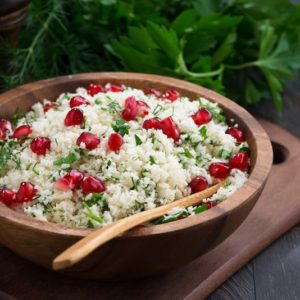Cauliflower makes an amazing substitute for regular bulgur wheat, allowing this recipe to stay gluten-free, and high in beneficial phytonutrients. Cauliflowers are cruciferous vegetables that contain compounds, called glucosinolates that can be converted by digestion and microbial action in the gut to derivative indoles, thiocyanates and isothiocyanates. These biologically active derivatives are known to prevent cancer, reduce inflammation, improve estrogen metabolism (important for men, as well as women), and support detoxification.
Other cruciferous veggies to look out for include arugula, bok choi, broccoli, Brussel Sprouts, cabbage, collard greens, kale, mustard greens, radish, turnip and watercress.
This recipe was originally posted on Dr. Kara Fitzgerald and is one of their favorite cleansing recipes from their 6-day online healthRESET detox program.

Cauliflower Tabbouleh
Ingredients
- 1 medium Cauliflower cut into florets
- 2 tbsp Olive Oil
- 1 Lemon Zest
- 1 Lemon Juice
- 1/2 cup parsley leaves chopped
- 1/2 cup Cilantro chopped
- 3 Scallions thinly sliced
- 1/2 cup pomegranate arils
- 1/2 cup black olives halved
- 1/2 cup walnuts roughly chopped
- 3-4 shakes kelp granules
- salt and pepper to taste
Instructions
- Finely chop the cauliflower until it resembles grains. You can do this very quickly in a food processor, by pulsing the cauliflower until done; be careful not to go too far).
- Optional for non-raw version: lightly cook the cauliflower grains, either in the oven on a baking sheet or in a saute pan with olive oil.
- In a large bowl, briefly whisk the olive oil, lemon zest and lemon juice together with a fork.
- Add the cauliflower “grains” and all remaining ingredients and toss well.
* These statements have not been evaluated by the Food and Drug Administration. The product mentioned in this article are not intended to diagnose, treat, cure, or prevent any disease. The information in this article is not intended to replace any recommendations or relationship with your physician. Please review references sited at end of article for scientific support of any claims made.
















Share: